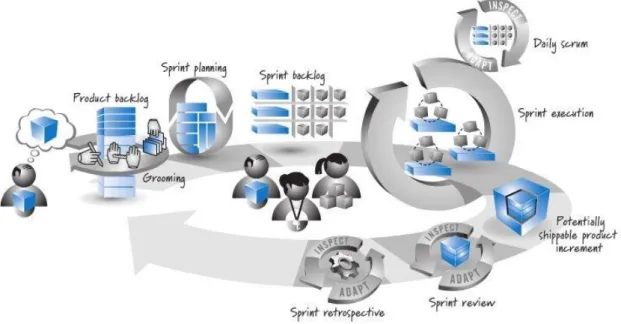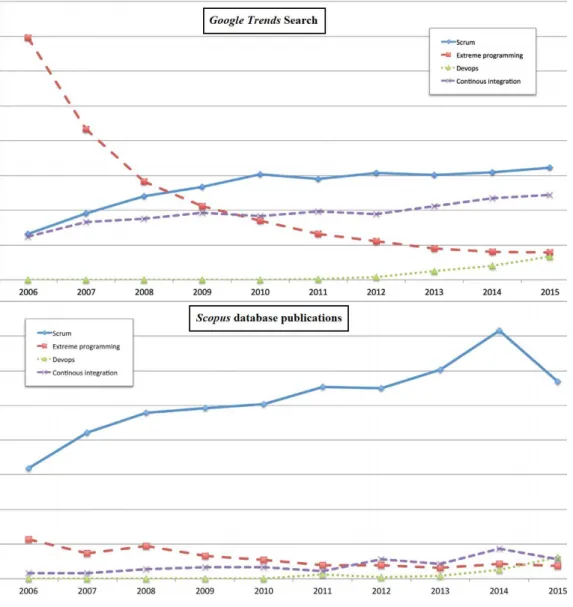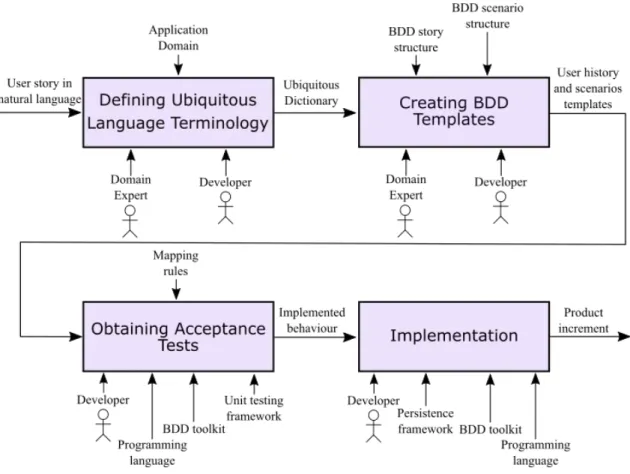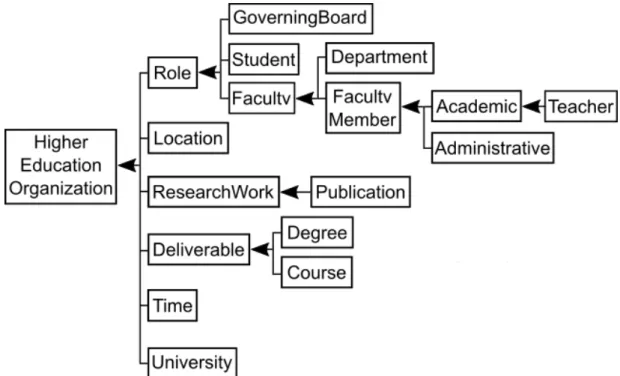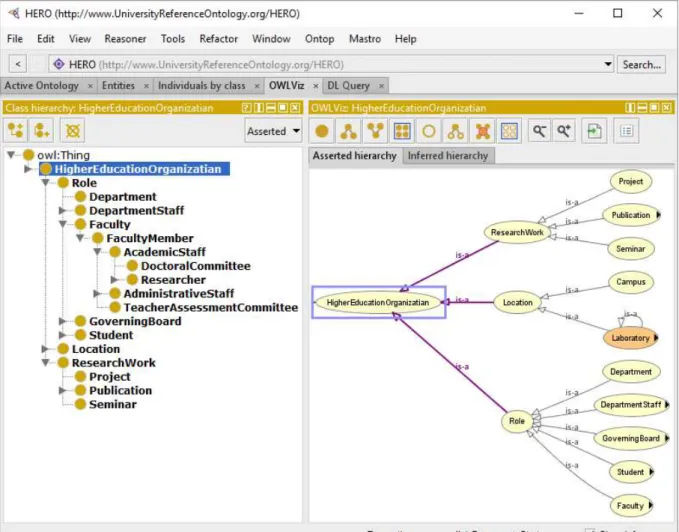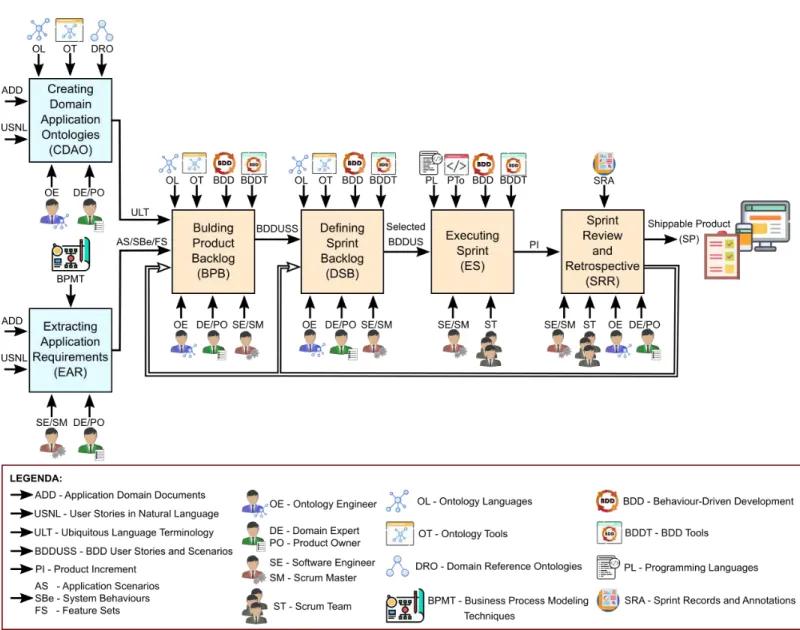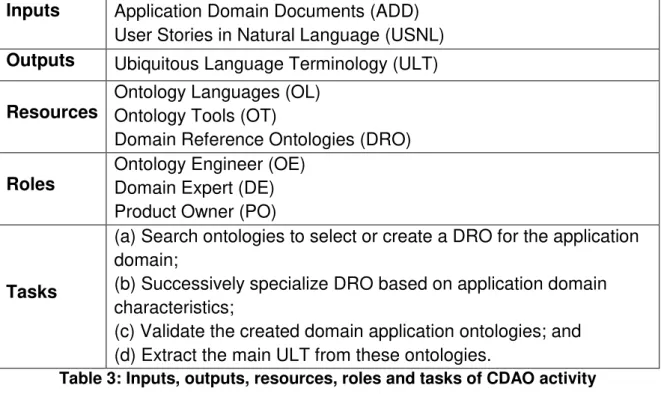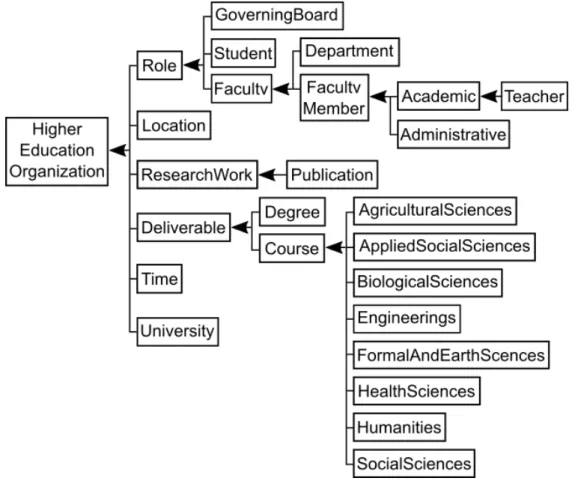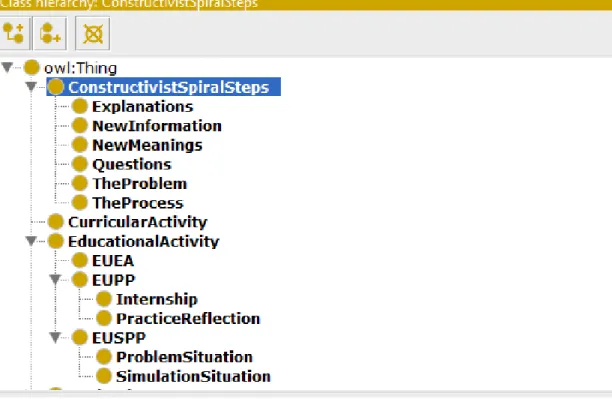UNIVERSIDADE FEDERAL DE SÃO CARLOS
CENTRO DE CIÊNCIAS EXATAS E DE TECNOLOGIA
PROGRAMA DE PÓS-GRADUAÇÃO EM
CIÊNCIA DA COMPUTAÇÃO
“
ScrumOntoBDD: uma abordagem baseada
em Scrum, Ontologia e BDD para o
desenvolvimento ágil de software
”
ALUNO: Pedro Lopes de Souza
ORIENTADOR: Prof. Dr. Antonio Francisco do Prado
São Carlos Agosto / 2018
CAIXA POSTAL 676 FONE / FAX: (16) 3351-8233 13565-905 - SÃO CARLOS - SP
CENTRO DE CIÊNCIAS EXATAS E DE TECNOLOGIA
PROGRAMA DE PÓS-GRADUAÇÃO EM CIÊNCIA DA COMPUTAÇÃO
ScrumOntoBDD: uma abordagem baseada em
Scrum, Ontologia e BDD para o desenvolvimento
ágil de software
P
EDROL
OPES DES
OUZADissertação apresentada ao Programa de Pós-Graduação em Ciência da Computação da Universidade Federal de São Carlos, como parte dos requisitos para a obtenção do título de Mestre em Ciência da Computação
S
ÍNTESE
A maioria das universidades brasileiras empregam metodologias tradicionais de ensino-aprendizagem, baseadas em disciplinas e aulas expositivas. A Universidade Federal de São Carlos (UFSCar) não é uma exceção, mas alguns de seus cursos empregam metodologias ativas de aprendizagem, tais como Aprendizagem Baseada em Problemas (ABP). O Grupo de Computação Ubíqua (GCU) da UFSCar, criado em 2002, vem desenvolvendo projetos principalmente voltados para as áreas de Educação e Saúde e recentemente coordenou o desenvolvimento do projeto Software de Gestão Pedagógica e Acadêmica para Cursos Baseados em Metodologias Ativas de Aprendizagem (SGPA-CBMAA). O método ágil Scrum foi empregado no desenvolvimento do SGPA-CBMAA, tendo sido realizadas reuniões periódicas envolvendo desenvolvedores e Product Owners (POs) para o planejamento e análise das diferentes fases do desenvolvimento do SGPA-CBMAA. Foi bastante comum a necessidade de refazer cenários de comportamentos desse sistema, devido às ambiguidades presentes em especificações de requisitos, ou devido às interpretações equivocadas de estórias relatadas pelos POs. A definição de conjuntos de teste também foi incômoda, resultando em conjuntos de teste incompletos ou que não atendiam aos requisitos do sistema. Com base nessa experiência e para lidar com esses problemas, este trabalho propõe a abordagem ScrumOntoBDD, que combina Scrum, Ontologia e Behaviour-Driven Development (BDD), para o desenvolvimento ágil de software. Essa abordagem explora os conceitos e técnicas de SCRUM e BDD, focando nas fases de planejamento e análise do ciclo de vida do software, já que as ferramentas do BDD fornecem pouco apoio a essas fases, e a maioria dos problemas encontrados no desenvolvimento do SGPA-CBMAA foram nas mesmas. ScrumOntoBDD emprega ontologias a fim de eliminar as ambiguidades intrínsecas ao uso de uma linguagem natural como linguagem ubíqua do BDD.
EXACT AND TECHNOLOGY SCIENCES CENTER GRADUATE PROGRAMME ON COMPUTER SCIENCE
ScrumOntoBDD: an approach based on Scrum,
Ontology and BDD for agile software development
P
EDROL
OPES DES
OUZAEXACT AND TECHNOLOGY SCIENCES CENTER GRADUATE PROGRAMME ON COMPUTER SCIENCE
ScrumOntoBDD: an approach based on Scrum,
Ontology and BDD for agile software development
P
EDROL
OPES DES
OUZADissertation presented to the Graduate Programme on Computer Science of the Federal University of São Carlos, as part of the requirements for obtaining a MSc’s degree in Computer Science
EXACT AND TECHNOLOGY SCIENCES CENTER GRADUATE PROGRAMME ON COMPUTER SCIENCE
ScrumOntoBDD: an approach based on Scrum,
Ontology and BDD for agile software development
PEDRO LOPES DE SOUZA
Dissertation presented to the Graduate Programme on Computer Science of the Federal University of São Carlos, as part of the requirements for obtaining a MSc’s degree in Computer Science
Concentration area: Software Engineering
Appproved on August ___ 2018.
Graduation Committee:
Prof. Dr. Antonio Francisco do Prado (Advisor – DC/CCET/UFSCar)
Prof. Dr. Valter Vieira de Camargo (DC/CCET/UFSCar)
Prof. Dr. Elisa Yumi Nakagawa
“Learning is the only thing the mind never exhausts, never fears, and never regrets.”
A
CKNOWLEDGEMENTS
This work would not have been possible without the help of important people around me. I will start by thanking my parents Wanderley e Inês for always trusting me, and supporting me during this entire journey. I am grateful to my sister Izabel and to my brother Adriano for all their love and care through these years of physical distance.
My sincere appreciation to Prof. Dr. Antonio Francisco do Prado for supervising me, encouraging my research, and for his patience, motivation, and enthusiasm through all the development of this MSc’s project.
My gratitude to Prof. Dr. Luís Ferreira Pires for his ideas and advices to improve this work, and for his intense participation in the publications resulting from this research.
I would like to thanks two people for advising me in essential matters for this project development: Prof. Sissi Marilia dos Santos Forghieri Pereira, an expert on the application domain addressed in this work; and Prof. Helen de Freitas Santos, an expert on the software system addressed in this work.
I am grateful to all my professors of the Graduate Programme on Computer Science (PPG-CC) of Federal University of São Carlos (UFSCar) for improving my knowledge with their lectures. Special thanks to Prof. Dr. Vânia Paula de Almeida Neris for helping me to define the evaluation process of the approach proposed in this MSc’s dissertation.
Yumi Nakagawa from Institute of Mathematical and Computer Sciences (ICMC) of University of São Paulo (USP) on the defence committee of my MSc’s dissertation.
I thank my fellow lab mates in UFSCar for the stimulating discussions, for working together mainly before deadlines, and for all the fun we have had in the last two years.
Last but not least, this study was financed in part by the Coordenação de Aperfeiçoamento de Pessoal de Nível Superior - Brasil (CAPES) - Finance Code 001- and I would like to thanks this agency for sponsoring this research.
A
BSTRACT
Most Brazilian universities employ traditional teaching-learning methodologies based on lectures classes. The Federal University of São Carlos (UFSCar) is not an exception, but some of its programmes employ active learning methodologies, such as Problem Based Learning (PBL). The Ubiquitous Computing Group (UCG) of UFSCar, which was established in 2002, has been developing projects focused mainly on the Education and Health areas, and recently coordinated the development of the project Educational and Academic Management System for Courses Based on Active Learning Methodologies (EAMS-CBALM). The Scrum agile method was employed in the EAMS-CBALM development, with periodic meetings involving developers and Product Owners (POs) for planning and analyzing the different EAMS-CBALM development phases. It was quite often necessary to redefine some system behaviour scenarios, due to ambiguities present in requirement specifications, or due to misinterpretations of stories reported by POs. The definition of test suites was also cumbersome, resulting in test suites that were incomplete or did not at all comply with the system requirements. Based on this experience and to deal with these problems, this work proposes the ScrumOntoBDD approach, which combines Scrum, Ontology and Behaviour-Driven Development (BDD), for agile software development. This approach explores the concepts and techniques of SCRUM and BDD, focusing on the planning and analysis phases of software life cycle, since the BDD tools provide little support to these phases, and most of the problems found in the EAMS-CBALM development were in those phases. ScrumOntoBDD employs ontologies in order to eliminate ambiguities intrinsic to the use of a natural language as a BDD ubiquitous language.
F
IGURES
L
IST
Figure 1 – Scrum roles, events, and artefacts ... 7
Figure 2 – A the top chart, Google Trends research. At the botton chart, Scopus publications database (from(Dingsoyr, 2016)) ... 9
Figure 3 – The BDD process in SADT ... 12
Figure 4 – BDD templates for user stories and scenarios ... 14
Figure 5 – Points for connecting BDD to Scrum ... 16
Figure 6 – Ontology classification ... 17
Figure 7 – Key concepts of HERO ontology ... 19
Figure 8 – Excerpt of HERO ontology in OWL...21
Figure 9 – Protégé 5.2.0 screenshot of the HERO ontology...25
Figure 10 – UFSCar Medicine Programme curriculum ... 26
Figure 11 – Movements of the constructivist spiral ... 27
Figure 12 – EAMS-CBALM academic module ... 30
Figure 13 – EAMS-CBALM pedagogical module ... 30
Figure 14 – Architectural pattern of EAMS-CBALM implementation ... 31
Figure 15 – ScrumOntoBDD overview ... 35
Figure 16 – HERO key concepts with CNPq major education areas ... 38
Figure 17 – UFSCar ontology in OWLViz ... 39
Figure 18 – UFSCar Medicine Programme ontology ... 40
Figure 19 – Constructivist spiral steps and educational activities of UFSCar Medicine Programme ontology ... 40
Figure 20 – Evaluation Process ontology root classes (left-side) and Meeting class relations (right-side) ... 43
Figure 22 – Results of Evaluation Process ontology processing: FaCT++ (top),
HermiT (middle) and Pellet (bottom ... 44
Figure 23 – Use case diagram for Instrument Types Registration requirement... 46
Figure 24 – System feature set for Instrument Types Registration requirement... 47
Figure 25 – OWL ontology for the BDD scenario template ... 48
Figure 26 – JBehave User Story and Scenario templates ... 50
Figure 27 – EFSM model representing PATLP instrument type registration ... 50
Figure 28 – User Story and Scenario ontology with PATLP instrument type registration... 51
Figure 29 – User Story and Scenario ontology transcript to JBehave textual story file ... 53
Figure 30 – Excerpt of the acceptance tests generated for the PATLP scenario ... 55
Figure 31 – Excerpt of the achieved implementation for the Instrument Types Registration requirement ... 56
Figure 32 – Evaluation Process ontology with extended PATLP ... 57
Figure 33 – Action Research cycle ... 60
Figure 34 – AR cycles of experimental analysis ... 64
Figure 35 – Activities in the Action Planning phases of the AR cycles ... .66
Figure 36 – Excerpt of UML use case diagram for Create People Performance Evaluation Format requirement ... 67
Figure 37-A– Excerpt of the Add People Performance Evaluation Format feature…68 Figure 37-B– Excerpt of the Add People Performance Evaluation Format feature…69 Figure 38 – Excerpt of Extended Evaluation Process ontology focusing on People Performance Evaluation Format ... 70
Figure 39 – Excerpt of the PB item selected in Cycle 1...70
Figure 40 – Excerpt of the PB item selected in Cycle 2 focusing on the selection of the target group for the evaluation format scenario ... 71
Figure 41 – Screen prototype for the selected PB item ...71
Figure 42 – Excerpt of the acceptance tests generated in Cycle 2 ...72
Figure 43 – Excerpt of the achieved implementation on Cycle 1...73
T
ABLES
L
IST
Table 1 –Supported BDD characteristics by the analyzed BDD tools...11
Table 2 – Supported programming languages by the analyzed BDD tools….……....11
Table 3 – Inputs, outputs, resources, roles and tasks of CDAO activity………...37
Table 4 – Evaluation instruments types…...……....42
Table 5 – Inputs, outputs, resources, roles and tasks of EAR activity………...45
Table 6 – Inputs, outputs, resources, roles and tasks of BPB activity...………....49
Table 7 – Inputs, outputs, resources, roles and tasks of DSB activity...………....52
Table 8 – Inputs, outputs, resources, roles and tasks of ES activity...………....54
Table 9 – Inputs, outputs, resources, roles and tasks of SRR activity………...56
Table – 10 Main results of the Evaluating phase of Cycle 1...88
A
CRONYMS
L
IST
ADD – Application Domain Documents AR – Action Research
AS – Application Scenarios
ATDD – Acceptance Test Driven Development BDD – Behaviour-Driven Development
BDDT – BDD Tools
BDDUSS – BDD User Stories and Scenarios BPB – Building Product Backlog
BPMN – Business Process Model Notation BPMT – Business Process Modeling Techniques
CBALM – Courses Based on Active Learning Methodologies CDAO –Creating Domain Application Ontologies
DAML+OIL –DARPA Agent Markup Language + Ontology Interchange Language DE – Domain Expert
DL – Description Logic
DMed – Medicine Department DR – Design Research
DRO – Domain Reference Ontologies DSB – Defining Sprint Backlog
DT – Development Team
EAMS-CBALM – Educational and Academic Management System for Courses Based on Active Learning Methodologies
ERP – Electronic Reflective Portfolio ES – Executing Sprint
EUEA – Education Unit of Elective Activities EUPP – Education Unit of Professional Practice
EUSPP – Education Unit of Simulation of Professional Practice Famema – Faculty of Medicine of Marília
FE – Free Edition F-logic –Frame Logic FS – Feature Sets
FSP – Faculty of Public Health H1– Hypothesis 1
H2– Hypothesis 2
HERO – Higher Education Reference Ontology ICT – Information and Communication Technologies
IFSP– Federal Institute of Education, Science and Technology of São Paulo IS – Information Systems
KIF –Knowledge Interchange Format KMI – Knowledge Media Institute LMS – Learning Management System ME – Maestro Edition
MIND – Maryland Information and Network Laboratory MVC – Model–View–Controller
OCML –Operational Conceptual Modelling Language OE – Ontology Engineer
OKBC – Open Knowledge Base Connectivity OL – Ontology Languages
OSEPP – Objective and Structured Evaluation of Professional Performance OT – Ontology Tools
OWL –Web Ontology Language
PATLP – Performance Assessment of the Teaching-Learning Process PB –Product Backlog
PI –Product Increment
PL – Programming Languages PO – Product Owner
PPG-CC – Graduate Programme on Computer Science PT – Progress Test
PTo – Programming Tools
RDF –Resource Description Framework RDFS – RDF Schema
RP – Reflective Portfolio RQ1– Research Question 1
RQ2– Research Question 2
SADT – Structured Analysis and Design Technique SB –Sprint Backlog
SBe – System Behaviours
ScrumOntoBDD – Approach based on Scrum, Ontology and BDD for agile software development
SE – Software Engineer SEd – Standard Edition
SHOE –Simple HTML Ontology Extensions SLH – Sírio-Libanês Hospital
SM –Scrum Master SP – Shippable Product SPr – Screen Prototypes
SRA – Sprint Records and Annotations SRR – Sprint Review and Retrospective ST –Scrum Team
SWAP – Semantic Web and Agents Project
SWOOP – Semantic Web Ontology Overview and Perusal SWRL – Semantic Web Rule Language
UFMG – Federal University of Minas Gerais UFSCar – Federal University of São Carlos UI – User Interface
ULT – Ubiquitous Language Terminology UML – Unified Modeling Language
UNICAMP – University of Campinas
UNIFESP – Federal University of São Paulo USNL – User Stories in Natural Language USP – University of São Paulo
W3C – World Wide Web Consortium WE – Written Examination
WG – Working Group
C
ONTENTS
CHAPTER 1 - Introduction ... 1 1.1Context ... 1 1.2Motivations and Objectives ... 2 1.3Structure of the Dissertation ... 3
CHAPTER 2 - THEORETICAL AND TECHNICAL BACKGROUND ... 5 2.1Agile Software Development ... 5 2.1.1Scrum ... 6 2.1.2Behaviour-Driven Development (BDD) ... 10
2.1.2.1 Ubiquitous Language………..12
2.1.2.2 BDD Templates……….13
2.1.2.3 Acceptance Tests……….14
2.1.2.4 Implementation……….15
2.1.3 Combining Scrum and BDD………..15
2.2Ontologies ... 16 2.2.1Ontology Classification ... 17 2.2.2 Ontology Languages...19 2.2.3 Ontology Tools...21 2.3Active Learning Methodologies ... 25 2.3.1UFSCar Medicine Programme ... 26 2.4Learning Management Systems ... 27 2.4.1 Educational and Academic Management System for Courses Based on Active
2.4.1.2 EAMS-CBALM Implementation ... 31 2.5 Final Considerations ... 31
CHAPTER 3 - SCRUMONTOBDD ... 34 3.1Overview ... 34 3.2Creating Domain Application Ontologies (CDAO) ... 37 3.2.1 Ubiquitous Language Terminology for EAMS-CBALM ... 38 3.2.1.1 Ubiquitous Language Terminology for Evaluation Management Module……41
3.2.2 Ontology Validation of EAMS-CBALM……….44
3.3 Extracting Application Requirements (EAR)………...45
3.3.1 Requirements for EAMS-CBALM………..…46
3.4 Building Product Backlog (BPB)……….…..48
3.4.1 User Story and Scenario Ontology for EAMS-CBALM………..49
3.5 Defining Sprint Backlog (DSB)………..51
3.5.1 Tasks for Implementing the Selected BDDUSS of EAMS-CBALM……….52
3.6 Executing Sprint (ES)……….53
3.6.1 Acceptance Tests for the Selected BDDUSS of EAMS-CBALM……….54 3.6.2 Implementation of the Selected BDDUSS of EAMS-CBALM………...55 3.7 Sprint Review and Retrospective (SRR)……….…56 3.7.1 Sprint Review and Retrospective for EAMS-CBALM……….57 3.8 Final Considerations ... 58
CHAPTER 4 - ScrumOntoBDD Analysis ... 59 4.1Action Research ... 59 4.2Objectives, Settings, and Participants ... 61 4.3 Experimental Analysis ... 63 4.3.1 Action Planning ... 64
4.3.2 Action Taking ... 66
4.3.3 Evaluating ... 74 4.3.4Specifying Learning ... 87 4.4 Final Considerations ... 91
5.2 Ontology Related Works ... 95 5.3 Final Considerations ... 96
CHAPTER 6 - CONCLUSION ... 98 6.1 Contributions and Limitations ... 98 6.2 Future Works ... 99
Chapter 1
I
NTRODUCTIONThis chapter presents an introduction to the theme of this MSc’s dissertation, its motivations and objectives. Section 1.1 addresses the context of this research; Section 1.2 deals with motivations and objectives; and Section 1.3 describes how the structure of this document is organized.
1.1 Context
Agile software development refers to iterative software development approaches, methodologies and methods, where requirements and solutions evolve through collaboration between customers and developers. Among them, the following stands out: Scrum (Schwaber, 2017) that prescribes sprint reviews, which are meetings involving the developer team and the Product Owner (PO) to plan and evaluate sprints; and Behaviour-Driven Development (BDD) (North, 2006), which prescribes the definition of usage scenarios (behaviour specifications) upfront as a way to better understand what the software is supposed to do (its ’behaviour’).
Languages, Engineering, Health, and Education. According to Guarino (Guarino, 1998), an ontology can impact an IS in a temporal dimension, concerning whether it is used at the IS development or run times, and in a structural dimension, concerning the way it affects the main IS components, i.e., application programs, databases, and user interfaces.
The Medicine Programme of the Federal University of São Carlos (UFSCar), located in São Carlos city at São Paulo (SP) state in Brazil, was established in 2006, and follows a socio-constructivist educational approach, has a competency-oriented pedagogical programme, and employs active learning methodologies, such as Problem Based Learning (PBL) (Rhem, 1998) and Practice Based Learning (Carlisle, 2009).
To provide computational support for courses that employ these methodologies, the Ubiquitous Computing Group (UCG) of UFSCar developed, in partnership with the UFSCar Medicine Department (DMed), the Teaching and Research Institute (TRI) of the Sírio-Libanês Hospital (SLH), and a software house, the Learning Management System (LMS) called Educational and Academic Management System for Courses Based on Active Learning Methodologies (EAMS-CBALM) (Santos, 2016).
1.2 Motivations and Objectives
EAMS-CBALM was developed using Scrum, and during its development, it was quite often necessary to redefine some system behaviour scenarios and, consequently, the Product Backlog (PB) items, due to misunderstanding of the stories reported by the PO. The definition of test suites was also cumbersome, resulting in test suites that were incomplete or did not at all comply with the system requirements.
RQ1- How to improve the communication between PO and developers?
RQ2 - How to eliminate the ambiguities intrinsic of using natural languages to
report user stories?
Based on these questions, we established two main hypotheses:
H1- Combining BDD with Scrum can improve this communication.
H2 - Employing ontologies can eliminate these ambiguities.
To verify the first hypothesis (H1), we developed a case study in the context of
the EAMS-CBALM, by employing a ubiquitous language for the Education domain together with BDD scenarios and acceptance tests, in order to allow the PO to follow and properly communicate with the developers throughout the development process. This work was reported in Souza (Souza, 2017).
To verify the second hypothesis (H2), we developed another case study in the
context of the EAMS-CBLAM, by employing domain ontologies to describe the UFSCar Medicine Programme, in order to reduce the ambiguities caused by using a natural language as a ubiquitous language. This work was reported in Souza (Souza, 2018).
The main objective of this MSc’s dissertation is to join these two works by means of an approach, which combines Scrum, Ontology and BDD, for assuring both hypotheses. This approach was named ScrumOntoBDD.
1.3 Structure of the Dissertation
After this introduction, this MSc's dissertation is organized as follow:
Chapter 3 presents ScrumOntoBDD, our proposed approach for agile software development, which combines Scrum, Ontology and BDD. First, an overview of this approach is provided, and then its main activities are detailed and exemplified with case studies related to the EAMS-CBLAM development.
Chapter 4 describes an experimental analysis of ScrumOntoBDD, whose main objective is to evaluate our two hypotheses when employing this approach. After an introduction to Action Research, the process used for this analysis, the experiment is described according to the Action Research cycle and phases, and its results are discussed in regard of our hypotheses.
Chapter 5 discusses some related works to our work, splitting them into two groups according to the systematic literature reviews carried out during the development of this MSc’s project: the first employing BDD for improving software development, and the second employing Ontology also for improving software development.
Chapter 2
T
HEORETICAL ANDT
ECHNICAL BACKGROUNDFor the development of this MSc’s project, it was fundamental to acquire knowledge in the areas of Agile Software Development, Ontologies, Active Learning Methodologies, and Learning Management Systems. Section 2.1 addresses the first area, dealing mainly with Scrum and BDD; Section 2.2 addresses the second area; Section 2.3 addresses the third area, dealing mainly with UFSCar Medicine Programme; Section 2.4 addresses the fourth area, dealing mainly with EAMS-CBLAM; and Section 2.5 has the final considerations.
2.1 Agile Software Development
“We are uncovering better ways of developing software by doing it and helping others
do it. Through this work we have come to value: Individuals and interactions over processes and tools Working software over comprehensive documentation Customer collaboration over contract negotiation Responding to change over following a plan
That is, while there is value in the items on the right, we value the items on the left
more.”
By using agile methods, the software is not developed as a single unit, but as a series of increments, each increment including some new system features. New releases of the system, corresponding to the produced increments, should be periodically available to the customers, and this period may vary from one week to one month depending on the system size and complexity.
Agile methods are usually employed to develop systems where their requirements can quickly change during the development process. Therefore, it is crucial to involve customers in this process so they can propose changes and new requirements for the next system increments.
The well-known agile methods include Extreme Programming (Beck, 2012), Crystal (Cockburn, 2004), Adaptive Software Development (Highsmith, 2000), DSDM (Stapleton, 2003), Feature Driven Development (Palmer, 2002), and Scrum (Schwaber, 2017).
2.1.1 Scrum
In Scrum, the units of work are divided in sprints, which can last between a week and a month, period in which the developers creates an increment of the product to be delivered to the customer. According to Rubin (Rubin, 2012) and as illustrated in Figure 1, Scrum is a framework for organizing and managing team work, and Scrum practices involve specific roles, events, and artefacts.
Figure 1: Scrum roles, events, and artefacts adapted from Rubin (Rubin, 2012)
The development of a product by employing Scrum may involve one or more Development Teams (DT), each one composed at least of three Scrum roles:
(a) Product Owner (PO), who can be designated by the costumer, is responsible for what will be developed and in what order, and for tracking product development;
(b) Scrum Master (SM) is responsible for promoting and supporting Scrum by helping the team understand its theory, practices, rules, and values; and
(c) Scrum Team (ST) is composed by professionals responsible for delivering at each sprint a usable increment of the product requested by the customer.
container for other techniques, methodologies, and practices.” During the Scrum development cycle the following main artefacts are produced:
(a) Product Backlog (PB) is a prioritized list of requirements stated as user stories, broken down (grooming) into a set of features, that reflects the PO vision of the product to be created;
(b) Sprint Backlog (SB) is a list containing a subset of PB items, followed by the tasks to be performed for each item, which the ST believes and commits to complete on that sprint; and
(c) Product Increment (PI) is a potentially shippable increment of the product, representing part of the PO's product vision, which is produced by ST at the end of sprint execution, and can be released to the customer.
To produce these artefacts, the following main events take place:
(a) Sprint Planning is a meeting involving SM and ST for planning the work to be performed in that sprint, which can last a maximum of eight hours for a one-month sprint or less for shorter sprints;
(b) Sprint Execution, where the ST guided by the SM performs the needed tasks to get the selected features done, and to produce a potentially shippable PI;
(c) Daily Scrum is a ST 15-minute meeting held every day of the sprint for planning the work within the next 24 hours, which allows for optimizing team collaboration and performance as the work produced since the last daily scrum is scrutinized, and sprint's next work is predicted;
(d) Sprint Review is a DT meeting held at the end of the sprint, which can last a maximum of four hours for a one-month sprint or less for shorter sprints, for inspecting the PI produced on that sprint, and for adapting the PB if needed; and
Recently, Dingsoyr (Dingsoyr, 2016) conducted a survey to visualize the trends of some development practices in the last ten years. To do that, they investigated the interest from developers and researches about the following topics from 2006 until 2016: Scrum, Extreme Programming, DevOp1 and Continuous Integration2.
Figure 2: A the top chart, Google Trends research. At the botton chart, Scopus publications
database (from(Dingsoyr, 2016))
1 DevOps can be understood as an interdisciplinary community of practices dedicated to the study of
the construction and evolulation of resilient systems of rapid change in scale. Source: <http://theagileadmin.com/what-is-devops/>
2 Continuous integration is a software development practice in which software is continuously
In the top chart of Figure 2, the interest in the past 10 years between developers based on Google Trends, and in the botton chart, the interest at the same period among researchers based on the Scopus publications database. Scrum stands out and its interest and use has been increasing over time. Probably, the decline in 2015 among researchers is related to the late indexing of articles in the database (Dingsoyr, 2016).
2.1.2 Behaviour-Driven Development (BDD)
Test Driven Development (TDD) is a software evolutionary development methodology, based on short development cycles, in which automated tests are described previously to the production of code (Beck, 2002). Acceptance Test Driven Development (ATDD) is a TDD variation, where software development is driven by acceptance tests, which are used to represent stakeholder’s requirements (Koskela, 2008).
Behaviour-Driven Development (BDD) is an agile software development methodology, originally proposed by North (North, 2006) and considered as an evolution of TDD and ATDD, whose fundamental principle is: "stakeholders and developers should refer to the same system in the same way". For achieving this goal, a ubiquitous language is required that is understandable by all those involved in system development and enables executable granular specifications of the system's behaviour and testing (Diepenbeck, 2014).
characteristics. This new analysis is summarized in. Tables 1 and 2 that shown BDD characteristics and languages supported by these tools.
Supported BDD characteristics xBehave Family
xSpec
Family StoryQ Cucumber SpecFlow
Ubiquitous language definition X X X X X X X
Iterative decomposition process X X X X X X X
Editing plain text based on
User story
template √ √ X X X √ √
Scenario template √ √ X X X √ √
Automated acceptance testing
with mapping rules √ √ X X X √ √
Readable behaviour oriented
specification code √ √ √ √ √ X √
Behaviour driven at different phases
Planning X X X X X X X
Analysis √ √ X X X √ √
Implementation √ √ √ √ √ X X
Table 1: Supported BDD characteristics by the analyzed BDD tools
xBehave Family xSpec Family StoryQ Cucumber SpecFlow
JBehave NBehaveRSpecMSpec
Supported
programming
languages
Java C# Ruby C# C# Ruby, Java,
Groovy, C#, etc C#
Table 2: Supported programming languages by the analyzed BDD tools
Figure 3: The BDD process in SADT based on the systematic review and analysis of BDD tookits
2.1.2.1 Ubiquitous Language
A ubiquitous language is essential in BDD. It must have a structure derived from a business domain model, offer a terminology that is understandable to both customers and developers, and be used in all system development phases (Evans, 2003). Therefore, a ubiquitous language must be created for the communication between the stakeholders and developers.
2.1.2.2 BDD Templates
The BDD analysis phase starts by identifying the most expected system behaviours, which are derived from the business outcomes to be produced by the system. Based on these business outcomes, feature sets are defined, where each feature set can contain subsets, and indicates what should be accomplished to achieve a specific business outcome.
This initial analysis may be sufficient for a first implementation, even if important system behaviours are yet undisclosed. However, as new behaviours are revealed, the whole process illustrated in Figure 2 can be performed again, thus characterizing the "iterative decomposition process" described in Solis (Solis, 2011).
Features and their acceptance criteria are expressed through user stories, and describe the interactions between a user and the system. A user story should elucidate the user’s role in this story, the feature desired by the user, and the benefit gained by the user if the system provides the desired feature. Due to different contexts, a user story may have different versions that will lead to different story instances, called scenarios, which in turn should describe specific contexts and outcomes of this user story.
A scenario describes how the system that implements a given feature should behave when it is in a main context with possible additional contexts that could be represented by additional conditions. When an event happens, e.g., a system entry, the scenario’s result can be one or more actions that change the state of the system or produce some system output.
clauses: (i) Given to provide main context that could be represented by a system state; (ii) When to describe a specific event that will trigger the Scenario; and (iii) Then to present the main outcome that could be an action for changing the system. Each one of these clauses can include an And statement to provide multiple contexts, events and/or outcomes. Each statement in this representation is called step. These templates are illustrated in Figure 4.
Title (one line describing the story)
Narrative: As a [role] I want [feature] So that [benefit]
Acceptance Criteria: (presented as Scenarios)
Scenario 1: Title Given [context]
And [some more context]... When [event]
Then [outcome]
And [another outcome]...
Scenario 2:
. . .
Figure 4: BDD templates for user story and scenarios (from (North, 2017))
2.1.2.3 Acceptance Tests
method, and the scenario passes only if all its steps pass. Each step follows the TDD’s process: red, green, and refactoring to make it pass.
Since in BDD all scenarios must be executed automatically, the acceptance criteria must also be imported and analysed automatically. The classes that implement the scenarios read their specifications, which are written in the ubiquitous language, and execute them. Therefore, the mapping between scenarios and testing code needs to be explicitly defined.
2.1.2.4 Implementation
In BDD the code must be readable, contain the specification, describe the behaviour of the objects and be part of the system documentation. The classes and methods names must be sentences, and the names of the methods must indicate their functionality. Mapping rules assist in the production of readable behaviour-oriented code and ensures that classes and methods names are the same as user story titles and scenarios, respectively. In addition, these names make use of the ubiquitous domain-specific language defined in the project.
2.1.3 Combining Scrum and BDD
According to Chauhan (Chauhan, 2016) and as illustrated in Figure 5, BDD can be employed in the following Scrum artefacts and rituals:
(a) Product Backlog and Sprint Backlog, BDD provides a common ground and language for transforming requirement into functional behaviour, and for changing functional behaviour into technical specification to be implemented;
(b) Daily Scrum meetings, BDD provides a common platform for understanding the development of each activity, and for avoiding any confusion and knowledge gap among the developers for producing the final implementation; and
Figure 5: Points for connecting BDD to Scrum (from (Chauhan, 2016))
Therefore, the combination of Scrum with BDD allows for a better visibility of what was required, why was needed and who has requested. As stated in Chauhan (Chauhan, 2016), this combination brings the following benefits: avoids misinterpretation of user stories; transform requirement into functional behaviour of the software; provide a common platform and vocabulary to understand requirement in better way; development team is aware of User Acceptance behaviour in advance for all user stories; as requirements (user stories) are inter-dependent, therefore helps in avoiding any confusion among development team; and spring meetings and daily scrum meetings are more effective.
2.2 Ontologies
The term ontology was introduced by philosophers in the seventeenth century as the philosophical study of nature and relationships of being. He appeared at a computer-related conference for the first time in 1967 (Mealy, 1967), and has since been employed in the fields Computer Science and Information Science.
objects, concepts, and other entities that are presumed to exist in some area of interest and the relationships that hold among them”.
Futhermore, according to Gruber (Gruber, 2008), “an ontology specifies the concepts, relationships, and other distinctions that are relevant for modelling a domain, and such specification takes the form of the definitions of representational vocabulary (classes, relations, and so forth), which provide meanings for the vocabulary and formal constraints on its coherent use”.
In Computer Science, ontologies have been used mainly in the following areas (Smith, 2001): Database and Information Systems; Artificial Intelligence; and Software Engineering. In the Artificial Intelligence context, ontology defines a set of representational terms, associating the names of entities in the universe of discourse (e.g., classes, relations, functions) with natural language texts that describe the meanings of these names, and with formal axioms that constrain the interpretation and the use of these terms.
2.2.1 Ontology Classification
There are several ontology classifications in the literature. As stated in Guarino (Guarino, 1998) and illustrated in Figure 6, ontology can be classified according to its generality and dependence levels into:
(a) Top-level ontology, also called upper or foundation ontology, describes very general concepts (e.g., Object, Property) that are independent of a particular domain;
(b) Domain ontology describes the vocabulary related to a generic domain (e.g., Medicine, Course) by specializing terms introduced in the top-level ontology;
(c) Task ontology describes the vocabulary related to a generic task (e.g., Diagnosing, Lecturing), by also specializing terms introduced in the top-level ontology; and
(d) Application ontologydescribes concepts depending on a particular domain and task (e.g., the roles played by domain entities while performing the activity of given a lecture), which are specializations of the related ontologies.
A top-level ontology aims at supporting semantic interoperability among domain ontologies, by providing a common basis for formulating definitions. The reuse and maintenance of systems supported by domain ontologies usually requires a merge of these ontologies, and if they are derived from the same high-level ontology, this merging can be performed automatically.
Unfortunately, most of the available domain ontologies are not derived from the same top-level ontology. Moreover, different domain perceptions, different usage intentions, and different languages, give rise to specific application ontologies in the same domain that are often incompatible. In order to deal with these problems, application ontologies can be constructed from a domain reference ontology.
Figure 7: Key concepts of HERO ontology adapted from (Zemmouchi-Ghomari, 2013))
2.2.2 Ontology Languages
In the last two decades, several languages have been developed for ontology formal description, allowing the knowledge representation related to specific domains, and often including reasoning rules for processing this knowledge. According to Berners-Lee (Berners-Lee, 2009), “a knowledge representation system must have the following properties: a reasonably compact syntax; a well defined semantics so that one can say precisely what is being represented; sufficient expressive power to represent human knowledge; an efficient, powerful, and understandable reasoning mechanism; and must be usable to build large knowledge bases.”
Ontology languages can be classified into two major categories, traditional and Web-based (Su, 2002). In the first category, there are languages based on: First-Order Predicate Logic, such as Knowledge Interchange Format (KIF) (Genesereth, 2004) and CycL (Cycorp, 2014); Frame, such as Frame Logic (F-logic) (Kifer, 1995) and Operational Conceptual Modelling Language (OCML) (Motta, 1998); and Description Logic (DL), such as Loom (MacGregor, 1991). In the second category there are Web standards and Web-based ontology languages compatible with Web standards.
Examples of Web standards are: EXtensible Markup Language (XML) (Bray, 2008) was developed by the World Wide Web Consortium (W3C) for encoding documents and data on the Web that are readable by human and machine; and Resource Description Framework (RDF) (Gandon, 2014) was also developed by W3C for describing Web resources and allowing the semantics specification of data based on XMLin a homogeneous and interoperable way.
Examples of Web-based ontology languages are: Simple HTML Ontology Extensions (SHOE) (Luke, 2000) is a HTML extension for incorporating semantic knowledge in Web pages by annotating them, and for providing categories, relations, inference rules, and rules to specify ontologies; DARPA Agent Markup Language + Ontology Interchange Language (DAML+OIL) (Connolly, 2001) is a semantic markup language proposed as a W3C standard for ontological and metadata representation, which includes aspects from OIL (Fensel, 2000) and is built on RDF Schema (RDFS) (Brickley, 2014); and Web Ontology Language (OWL) (W3C, 2012) is the W3C standard ontology language for the Semantic Web.
OWL was created in 2001 by a W3C Working Group (WG) as an RDS extension compatible with previous ontology languages (e.g., SHOE, DAML+OIL), but more powerful from them for expressing semantics. It includes conjunction, disjunction, existentially, and universally quantified variables for doing inferences and deriving knowledge.
DL and OWL Lite. OWL2 is the latest OWL version, keeps OWL Full and OWL DL, adds richer datatypes, qualified cardinality restrictions, reflexive, asymmetric and disjoint properties, and defines different profiles: OWL 2DL, OWL 2EL, OWL2 QL, and OWL 2RL.
We employed OWL in this MSc’s project for specifying our ontologies since this language is Web-based, is a standard for the Semantic Web, is compatible with several other ontology languages, and is used by a large community in many contexts. Figure 8 depicts an excerpt of HERO ontology in OWL showing some key concepts of this ontology.
Figure 8: Excerpt of HERO ontology in OWL
2.2.3 Ontology Tools
When starting out an ontology development, either from scratch or by reusing existing ontologies, it is very important to look for appropriated tools. Although there are many free and commercial ontology tools that offer different functionalities, most of them do not allow the ontology developers to interchange their ontologies from one tool to another.
particular, ontology editors allow users to manipulate, inspect, browse, and code ontologies, and special attention has being given in recent years to the Semantic Web editors responsible for creating and manipulating ontologies (Alatrish, 2013).
Several ontology editors related to the Semantic Web can be found on the Internet, and some of them are used by a large number of people. Among the most requested of these editors stand out: Apollo (KMI, 2004), Semantic Web Ontology Overview and Perusal (SWOOP) (MIND SWAP, 2004), TopBraid Composer (TopQuadrant, 2011), and Protégé (Musen, 2015). Apollo, SWOOP and Protégé are open source, and TopBraid Composer (FE) is under software license.
Apollo was developed by the Knowledge Media Institute (KMI) of The Open University, and allows users to model ontology with basic primitives, such as classes, instances, functions, and relations. Its internal model is a frame based on the Open Knowledge Base Connectivity (OKBC) protocol, and its knowledge base is a hierarchical organization of ontologies. Each ontology can inherit other ontologies and use their classes, and every ontology inherits at least a default ontology that contains all primitive classes (e.g., Boolean, integer, float, string, list). Each class can create several instances that inherit all slots from that class, and each slot consists of a set of facets. According to KMI (KMI, 2004), Apollo has the following main features: full consistency check during editing; open design based on views; special dialog for quick creation of anonymous instances; I/O plug-in architecture - export plug-ins to CLOS and OCML; and Java based user-interface.
one can "view the source" of ontologies and their entities in a number of common syntaxes (e.g., RDF/XML, OWL Abstract Syntax, Turtle); OWL reasoners can be integrated for subsumption, consistency checking, etc., and default reasoners include a RDFS-like simple reasoner and Pellet, a Description Logic Tableaux Reasoner; ontology change management with extensive rollback and undo mechanisms; Share Annotations on Ontologies using the Annotea Protocol, and also attach and distribute Ontology Change sets with Annotations; search across multiple ontologies and 'find all references' of an OWL named entity; compare entities using a Resource Holder; Export Ontologies directly to a remote WebDav store.
TopBraid Composer was developed by the TopQuadrant Incorporation, and allows users to create and manage domain models and ontologies in RDF, RDFS, and OWL, offering them visual editing, and interoperability with Unified Modeling Language (UML) (OMG, 2017), XML Schema and databases. It is based on the Eclipse platform and Jena API, and integrates rule-based reasoning engines, offering a form-based user interface with the ability to view and edit ontologies in several serialization formats. Testing, consistency checking and debugging is supported by built-in OWL Inference engine, SPARQL query engine and Rules engine. It makes easier for an enterprise to move to Semantic Web standards by importing legacy models including XML Schemas, UML, RDB Schemas and spreadsheets. Open APIs are available, it can run with the database back-end for improve scalability. According to TopQuadrant (TopQuadrant, 2011), TobBraid Composer comes in three editions: Free Edition (FE) is an introductory version with only a core set of features; Standard Edition (SEd) includes all features of FE plus other features such as graphical viewers, import facilities, and advanced refactoring support; Maestro Edition (ME) includes all features of SE plus other features such as support for TopBraid Live, EVN and Ensemble as well as SPARQLMotion.
restrictions, relationships between classes, and properties of these relationships. It comes with visualization packages, such as OntoViz and Jambalaya, for visualizing ontologies with the help of diagrams, and supports collaborative ontology editing as well as annotation of ontology components and ontology changes. It includes an interface for the Semantic Web Rule Language (SWRL) for mathematical and temporal reasoning, and adds Prolog-type reasoning rules. According to Musen (Musen, 2015), Protégé currently exists in a variety of frameworks, and is offered in Web-based and Desktop-based systems.
We employed Protégé in this MSc’s project for supporting the development of our ontologies because it is a widespread platform recognized for its scalability and extensibility, which provides a tool set for building domain models and knowledge-based applications with ontologies. Furthermore, it is a free and open-source platform that has been continuously improved by Stanford University. According to Harith (Harith, 2005), Protégé is a killer application since it is a highly transformative technology that creates new markets and behaviour patterns.
Figure 9: Protégé 5.2.0 screenshot of the HERO ontology
2.3 Active Learning Methodologies
With respect to the formal education in Brazilian universities, most of them employ traditional teaching-learning methodologies based on lectures classes. UFSCar is not an exception, but some of its programmes employ active learning methodologies. In particular, the UFSCar Medicine Programme, which was established in 2006, follows a socio-constructivist educational approach, has a competency-oriented pedagogical programme, and employs active learning methodologies, such as Problem Based Learning (PBL) (Rhem, 1998), and Practice Based Learning (Carlisle, 2009).
2.3.1 UFSCar Medicine Programme
Differently from traditional lecture courses, the UFSCar Medicine Programme curriculum is based on educational activities organized in three educational units as illustrated in Figure 10: Education Unit of Simulation of Professional Practice (EUSPP), Education Unit of Professional Practice (EUPP), and Education Unit of Elective Activities (EUEA). At the beginning of the programme the students have more EUSPP activities than EUPP and this is reversed throughout the programme (UFSCar, 2007).
Figure 10: UFSCar Medicine Programme curriculum
exercised by the graduates of this programme. These triggers activate the movements of the constructivist spiral illustrated in Figure 11, encouraging students to reflect, and stimulating them to develop their capacities. From each learning trigger, the students traverse all these movements, starting by identifying the problem, then formulating explanations, preparing learning questions, looking for new information, building new meanings, and finally evaluating the process.
Figure 11: Movements of the constructivist spiral
The Reflective Portfolio (RP) is a tool for recording and monitoring student activities, widely used in courses that employ active learning methodologies, since it is a flexible and evidence-based instrument that motivates the students to a continuous reflection, and a collaborative analysis of learning (Zubizarreta, 2009). In the UFSCar Medicine Programme, this portfolio is used in all student activities, both in the internal and external to the university campus, and at the beginning of this programme the media of this tool was 100% paper.
2.4 Learning Management Systems
variety of learning purposes that range from add-on functions in conventional classrooms to full substitution for the face-to-face meetings by online encounters”.
In order to support E-learning, the institutions usually employ a Learning Management System (LMS), which is a software application to assist, for example, in the administration, documentation, delivering of courses, applying tests, and tracking students’ progress. In particular, LMS improves real-time interaction processes, allowing a student to have immediate contact with the teacher and other students.
There are many commercial and open source LMSs available, and most of them are Web-based for facilitating the users’ access. In (E-learning, 2018) there are short descriptions of 302 LMSs, and two lists of the top 20 of these LMSs, one based on the best user experience, and the other based on the best customer experience. Moodle (Moodle, 2018) belongs two both lists and is employed by UFSCar to support the majority of its academic programmes. However, it is not used by the programmes based on active learning methodologies, such as Medicine and Nursing programmes, since this LMS is too generic for supporting the specificities of these programmes.
The UCG/UFSCar, which was established in 2002, has been developing projects focused mainly on the Education and Health areas. In the Health Education domain it developed, in partnership with DMed/UFSCar, the Electronic Reflective Portfolio (ERP) project (Forte, 2013). Recently, the UCG/UFSCar developed, in partnership with the DMed/UFSCar, the Teaching and Research Institute (TRI) of the Sírio-Libanês Hospital (SLH), and a software house, the LMS named Educational and Academic Management System for Courses Based on Active Learning Methodologies (EAMS-CBALM) (Santos, 2016).
2.4.1 Educational and Academic Management System for Courses Based on Active Learning Methodologies (EAMS-CBALM)
student. There were also monthly meetings at TRI/SLH in São Paulo-SP to present the PIs resulting from the sprints, involving the participants of the software house meetings and TRI/SLH members directly or indirectly related to the project. In addition, the PhD’s student participated on courses offered by the DMed/UFSCar and the TRI/SLH to observe the teaching-learning process of these courses.
During the software house meetings the POs reported stories, informally in Portuguese, describing what the activities of the EAMS-CBALM users would be. Then, from these stories system requirements were captured and specified also informally in Portuguese. Using these requirement specifications, the software house developer team defined system behaviour scenarios and implemented the screen prototypes for these scenarios, which were presented and discussed at the next meeting.
These meetings totalled 109 hours, which mainly allowed the understanding of CBALM teaching-learning process, defining the functional and non-functional system requirements, and defining the system architecture.
2.4.1.1 EAMS-CBALM Functional Architecture
Figure 12: EAMS-CBALM academic module
The pedagogical module, illustrated in Figure 13, reflects the curricular structure over each class of each course previously recorded in the academic module. The educational actions are programmed in the pedagogical module giving rise to the educational environment on which students and teachers will perform and record their activities. The planning of an educational action starts with the meetings preparation, each meeting corresponding to a movement of the constructivist spiral, and ends with the evaluations preparation.
Figure 13: EAMS-CBALM pedagogical module
knowledge sharing produced by other students and teachers. All these resources contribute for the student capabilities development leading to the knowledge production.
Another EAMS–CBALM feature regards the data visualization, since all educational content produced during the teaching-learning process is provided by means of a curricular trajectory. This content includes from the teaching contribution until the individual and collaborative knowledge produced by the students.
The curricular trajectory can be viewed in a timeline or associated with an educational unit, allowing students and teachers to visualize all developed practices in the most adequately way at every moment. In addition, the produced knowledge is indexed by keywords, facilitating the search of any content created throughout the teaching-learning process.
2.4.1.2 EAMS-CBALM Implementation
In order to obtain scalability, interoperability, and maintainability the EAMS-CBALM was built decoupling the front-end from the back-end according to a Model– View–Controller (MVC) like pattern. This architectural pattern is illustrated in Figure 14: the Presentation layer is the front-end and corresponds to View; the Controller and Rest Services layer corresponds to Controller; and Model was split into a Business layer and an Integration and Persistence layer, to get more flexibility and to facilitate even more the maintenance of this system, and they compose the back-end.
The communication between Presentation and Business layers is done by controllers that are accessible through HTTP calls using REST services, allowing in this way the front-end to exchange documents in the JSON format with the back-end. The Presentation layer pages are not rendering on the back-end, the requests in the front-end take place through JavaScript calls encapsulated in the AngularJS framework, and this pages are rendered with their data through this framework. The Business layer is implemented through Grails Web framework services that encapsulate the processing logic, and access the Integration and Persistence layer, which is composed of domain classes. The EAMS-CBALM employs the PostgreSQL relational database.
By decoupling front-end and back-end, it is expected to reduce server burden, leaving it solely responsible for handling business rules and data persistence. In addition, this type of approach enables a more distributed deployment of the system, facilitating the load balancing and the resource scheduling on demand.
2.5 Final Considerations
In this chapter we presented a literature review on the main concepts and techniques that served as the basis for the development of this MSc’s project. Throughout the chapter, the fundamental concepts discussed are related to agile software development, ontologies, active learning methodologies and learning management systems.
In the ontologies section, the concepts, classifications, mains ontologies languages and tools were presented and discussed. Inside that context, we selected OWL and Protégé as the ontology language and tool for this MSc’s project. Futhermore, both were illustred using HERO, a domain ontology created by Zemmouchi-Ghomari (Zemmouchi-Ghomari, 2013), that is also used in this project to develop the main ontologies presented in the next chapters.
In the active learning methodologies section, we presented the UFSCar Medicine Programme, a that follows a socio-constructivist educational approach, has a competency-oriented pedagogical programme, and employs active learning methodologies, such as PBL (Rhem, 1998), and Practice Based Learning (Carlisle, 2009). Details were given about the Programme structure and and its educational activities to provide a clear overview of how this formal education works.
Chapter 3
S
CRUMO
NTOBDD
This chapter presents the ScrumOntoBDD approach for agile software development, which combines Scrum, Ontology and BDD. Section 3.1 gives an overview of this approach focusing on its main activities, and from Section 3.2 until Section 3.7 these activities are detailed and illustrated with excerpts of the case studies related to the EAMS-CBLAM development; Section 3.8 has the final considerations.
3.1 Overview
The main ScrumOntoBDD activities are: Creating Domain Application Ontologies (CDAO), Extracting Application Requirements (EAR), Building Product Backlog (BPB); Defining Sprint Backlog (DSB), Executing Sprint (ES), and Sprint Review and Retrospective (SRR). CDAO and EAR can be performed in parallel with some overlapping. ES can be performed several times until a given PI is achieved, and after SRR is performed and the PI is accepted, a new sprint backlog is defined. The sprint review and sprint retrospective were joined in the same activity since they are performed in sequence involving all the DT members. The Shippable Product (SP) will be complete after all PB items have been processed successfully.
The inputs and outputs of these activities are: Application Domain Documents (ADD), User Stories in Natural Language (USNL), Ubiquitous Language Terminology (ULT), Application Scenarios (AS), System Behaviours (SBe), Feature Sets (FS), BDD User Stories and Scenarios (BDDUSS), Selected BDDUSS, and Product Increment (PI).
The main resources employed by these activities are: Ontology Languages (OL), Ontology Tools (OT), Domain Reference Ontologies (DRO), Business Process Modeling Techniques (BPMT), BDD, BDD Tools (BDDT), Programming Languages (PL), Programming Tools (PTo), and Sprint Records and Annotations (SRA).
The DT should be multidisciplinary and must accomplish the following roles:
(a) Domain Expert (DE) is responsible for sharing his/her knowledge of the application domain, and for transferring the necessary information to create the ontologies and to extract the application requirements;
(b) Ontology Engineer (OE) is responsible for creating, manipulating and evaluating the domain application ontologies, and also for assisting the formalization of knowledge and of software requirements;
(d) Product Owner (PO), Scrum Master (SM), and Scrum Team (ST) have the same Scrum roles described in section 2.1.1 of this document, and additionally SM and ST must also be able to handle BDD and BDD tools.
Some DT roles can be played by the same person. For example, the PO designated by the customer could be a DE, and the SM designated by the software house could be a SE.
These main activities of ScrumOntoBDD will be detailed in the next sections, and will be illustrated using excerpts of the case studies reported in (Souza, 2017) and (Souza, 2018) related to the EAMS-CBALM development.
3.2 Creating Domain Application Ontologies (CDAO)
The CDAO activity can start from a reference ontology for the application domain, and if there is no such ontology it can be built. Then this reference ontology must be gradually specialized to achieve an ontology containing the main terminology of the ubiquitous language to be employed in the application development. Table 3 summarizes the inputs, outputs, resources, roles and the main tasks of this activity.
Inputs Application Domain Documents (ADD) User Stories in Natural Language (USNL) Outputs Ubiquitous Language Terminology (ULT)
Resources Ontology Languages (OL) Ontology Tools (OT)
Domain Reference Ontologies (DRO)
Roles Ontology Engineer (OE) Domain Expert (DE) Product Owner (PO)
Tasks
(a) Search ontologies to select or create a DRO for the application domain;
(b) Successively specialize DRO based on application domain characteristics;
(c) Validate the created domain application ontologies; and (d) Extract the main ULT from these ontologies.
3.2.1 Ubiquitous Language Terminology for EAMS-CBALM
Based on HERO key concepts shown in Figure 7, and according to the higher education areas described by the National Council for Scientific and Technological Development (CNPq) of Brazil, we extended this reference ontology to be able to describe the Brazilian universities. Figure 16 shows this extension with the CNPq major educational areas.
Founded in 1968, UFSCar is a Brazilian public higher education institution, headquartered in the city of São Carlos, it has forty-eight academic departments, located in eight centers distributed over four campi, and its academic programmes are organized according to the CNPq large education areas.
Figure 16: HERO key concepts with CNPq major education areas
the eight CNPq large educational areas, and focuses on the ten UFSCar programmes in the Health Sciences area, where the Medicine Programme is located.
Figure 17: UFSCar ontology in OWLViz
Figure 18: UFSCar Medicine Programme ontology
